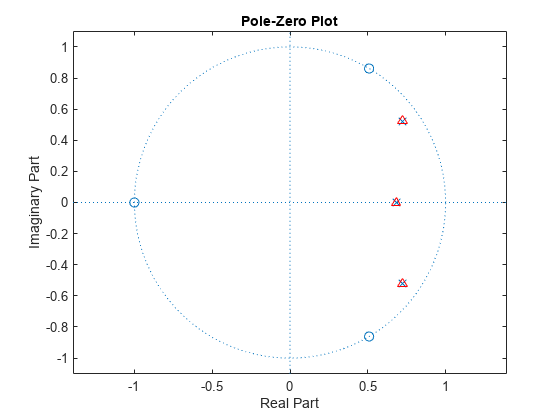residuez
Z 변환 부분 분수 전개
설명
residuez를 사용하여 다항식 계수를 유수, 극점, 직접 항으로 변환하거나 그 반대로 변환합니다.
예제
입력 인수
출력 인수
알고리즘
residuez는 두 다항식의 비로 표현된 이산시간 시스템을 부분 분수 전개 즉, 유수(residue) 형식으로 변환합니다. 또한 부분 분수 전개를 원래 다항식 계수로 다시 변환합니다.
참고
수치적으로, 다항식 비의 부분 분수 전개를 구하면 불량 조건 문제가 나타납니다. 분모 다항식이 중근을 갖는 다항식에 가까운 경우, 데이터의 작은 변화(예: 반올림 오차)가 결과 극점 및 유수에 가늠할 수 없는 큰 변화를 일으킬 수 있습니다. 대신에 상태공간 표현 또는 극점-영점 표현을 사용해야 합니다.
residuez는 표준 MATLAB® 함수와 부분 분수 기법을 적용하여 b와 a에서 r, p, k를 구합니다. 다음도 구할 수 있습니다.
length(b)>length(a)-1인 경우deconv(다항식의 장제법(Long Division))를 사용하여 직접 항a를 구합니다.p=roots(a)를 사용하여 극점을 구합니다.중복도에 따라 극점을 재정렬하여, 반복되는 극점을 구합니다.
b(z)/a(z)와 (1 – pjz–1)을 곱하고 그 결과로 발생한 유리 함수를 z = pj에서 실행하여, 반복되지 않는 각 극점 pj의 유수를 구합니다.
반복되는 극점의 유수를 구합니다. 그 방법은 다음 식에서
S2*r2 = h - S1*r1
\를 사용하여r2에 대한 해를 구하는 것입니다.h는 감소된 b(z)/a(z)의 임펄스 응답이고,S1은 반복되지 않는 근으로 구성된 1계 시스템의 임펄스 응답이고,r1은 반복되지 않는 근의 유수를 포함한 열입니다. 행렬S2의 각 열은 임펄스 응답입니다. 중복도 sj의 각 근이 pj인 경우S2에는 다음 각 시스템의 임펄스 응답을 나타내는 sj개의 열이 포함됩니다.벡터
h와 행렬S1및S2는n+xtra개의 행을 갖습니다. 여기서n은 근의 총 개수이고, 기본적으로 1로 설정되는 내부 파라미터xtra는 연립방정식의 과결정 정도를 확인합니다.
참고 문헌
[1] Oppenheim, Alan V., and Ronald W. Schafer, with John R. Buck. Discrete-Time Signal Processing. 2nd Ed. Upper Saddle River, NJ: Prentice Hall, 1999.
버전 내역
R2006a 이전에 개발됨
